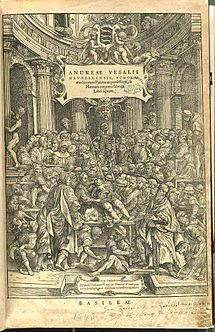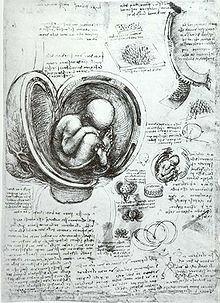- Medical Renaissance
-
 The front cover illustration of De Humani Corporis Fabrica, On the Fabric of the Human Body, written by Andreas Vesalius, showing a public dissection being carried out by Vesalius himself.
The front cover illustration of De Humani Corporis Fabrica, On the Fabric of the Human Body, written by Andreas Vesalius, showing a public dissection being carried out by Vesalius himself.
Medical Renaissance is the term often applied to the period, around 1400 to 1700, of major progress in medical knowledge and a renewed interest in the ancient ideas of the Greeks and Romans.[1] This movement was made possible by the Reformation of the Church, a decline in Conservatism, the work of individuals such as Andreas Vesalius & William Harvey and technological advances. All of these took place during the Renaissance period.[2]
Despite the medical advances made during this period, it would take many hundreds of years before the effects of the progress would be felt, even by the people highest in the social ranks; Charles II of England died at the age of 55, in 1685, of a stroke, despite having some of the most respected and educated doctors in the country treating him. They tried methods such as bleeding, laxatives and giving him a potion containing a bezoar stone, despite these methods having been proved ineffective by Ambroise Paré and having been made inferior by other treatments that were developed during this time.[3]
Contents
Factors
Without several interlinking factors, the progress made during the Medical Renaissance towards medical understanding could not have been possible.[4][5]
Science and technology
One of the most important inventions of the Renaissance was the Printing Press;[6] in the Middle Ages books were written by hand, by monks and scholars, and therefore were few in number and very precious, so very few left the monasteries where they were kept. The Printing Press lead to the creation of thousands of copies of books, containing no mistakes, and had a dramatic impact on Medicine during this time.[7] This meant that the books containing these new ideas could be spread quickly and accurately. They also were able to contain detailed drawings made by artists such as Leonardo da Vinci, which accompanied the text. For the first time physicians had detailed, accurate drawings of the human body.
The Microscope was another very important invention which occurred during the Renaissance and would continue to be improved upon until modern times, though the writings of Seneca and Pliny the Elder mention 'magnifying glasses' as far back as the first century A.D.[8]. In the 17th Century, Anthony van Leeuwenhoek made microscopes with magnification up to 270X, and was able to see micro-organisms; nobody suggested, however, that these were the cause of disease and for hundreds of years no progress would be made upon the matter. The microscope would later be used by both Pasteur and Koch, to view micro-organisms, and to help them to make vital discoveries.
Protestant Reformation
The Reformation of the Roman Catholic Church during this time was itself due to many things, including the perception of corruption within the Church.[citation needed] The ideas of Galen, a Greek physician of the 2nd century AD, were enforced and adopted by the Church; Galen was a Monotheist and his ideas did not question any of the Church's, additionally his ideas had been the accepted wisdom of the medical world for over a thousand years; anyone who went against these ideas were either punished or suppressed, and that was unlikely considering that the Church controlled the teachings that went on inside the medical profession and universities. Individuals such as Vesalius (see below) found it very difficult to overcome such opposition and were forced to dissect human subjects in secret, because it was banned. However once they began investigating they found things which challenged Galen's theories on the human body,[9] because Galen had only been able to dissect animals. In 1531 Johannes Guinter published a Latin translation of 'On Anatomical Procedures', written by Galen, in which he stressed the need to dissect human bodies, bringing to light a previously unknown approval of human dissection. This discovery would prove vital in the lifting of the ban on human dissections. Thanks to the recent invention of the printing press (see above), news of the discoveries made by individuals such as Vesalius was impossible for the Church to stop spreading, having been severely weakened by the Reformation.
Individuals
William Harvey
Main article William Harvey
William Harvey was an English medical doctor-physician, most famous for his contributions in heart and blood movement. Although not the first to propose pulmonary circulation (Ibn an-Nafis, Servetus and Columbo preceded him), he is credited as the first person in the Western world to give quantitative arguments for the circulation of blood around the body. [10] Previous thought had believed blood to be transformed food made in the liver and that it was consumed by the tissues, not recirculated. Harvey calculated that 600 lbs of blood was pumped per day, therefore making the hypothesis absurd. Without his contributions, the development of medical science and its life-saving ability would have been severely impeded. He was the foundation for all modern research on the heart and blood vessels. He got a degree for medical studies at age 16 at Oxford.[11]
Andreas Vesalius
Main article Andreas Vesalius
Vesalius was a Flemish-born anatomist whose dissections of the human body helped to correct the misconceptions made in Ancient Times, particularly by Galen, who (for religious reasons) had been able only to study animals such as dogs and monkeys.[12] Dissection of human bodies was still frowned upon in Vesalius' time (1514-64), as it had been for many hundreds of years, and Vesalius was forced to take the bodies of executed prisoners in secret. He wrote many books on anatomy from his observations, most notably 'De Humani Corporis Fabrica', which contained detailed drawings of the human body posed as if alive.[13]
Ambroise Paré
Main article Ambroise Paré
Paré was a French Surgeon, anatomist and inventor of many surgical instruments. Through 1533–36 he was a military surgeon during the French campaigns in Italy. It was here that, having run out of boiling oil, which was the accepted way of treating firearm wounds, Paré turned to an ancient roman remedy of turpentine, egg yolk and oil of roses. He applied it to the wounds and found that it relieved pain and sealed the wound effectively. As well as this breakthrough Paré also introduced the ligatures of arteries; silk threads would be used to tie up the arteries of amputated limbs to try and stop the bleeding, unfortunately, as antiseptics had not yet been invented this method lead to an increased fatality rate and was quickly abandoned by medical professionals of the time.[14]
Additionally, Paré set up a school for midwives in Paris and designed artificial limbs.[15]
Impact
Many of the discoveries made during the Renaissance had a major impact on the medical community as they disproved Galen's theory of the opposites, something that had been previously believed for centuries. However, Galen's theories were still widely accepted despite having been disproven by these discoveries
References
- ^ "Renaissance Medicine, From the Hutchinson Encyclopedia of World History". The History Channel. 2006. http://www.thehistorychannel.co.uk/site/encyclopedia/article_show/Renaissance_medicine/m0097012.html. Retrieved 2009-02-18.
- ^ Renaissance medicine
- ^ Renaissance medicine - Hutchinson encyclopedia article about Renaissance medicine
- ^ OCR GCSE: Medicine Through Time
- ^ Parragon, World History Encyclopedia
- ^ History of the Printing Press - Invention of the Printing Press
- ^ OCR GCSE: The Development of Medicine
- ^ Microscope History
- ^ Heinemann: Medicine Through Time
- ^ Spotlight Science 9 (GCSE Science Text Book)
- ^ Kids Work! > History of Medicine
- ^ Andreas Vesalius
- ^ BBC - History - Andreas Vesalius (1514-1564)
- ^ Grendler, Paul F. (1999). Encyclopedia of the Renaissanc. New York: Scribner's. pp. 399. ISBN 0-684-80511-1.
- ^ Ambroise Pare
Categories:
Wikimedia Foundation. 2010.

